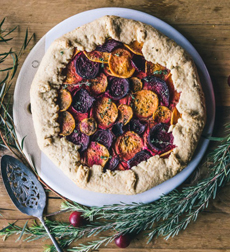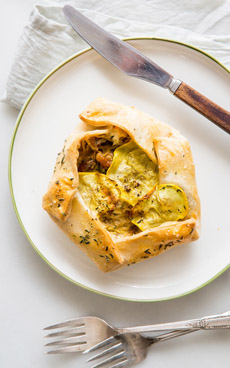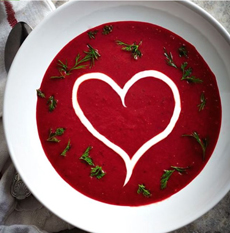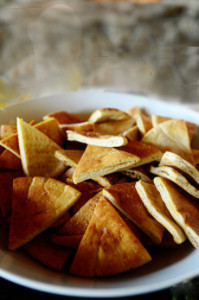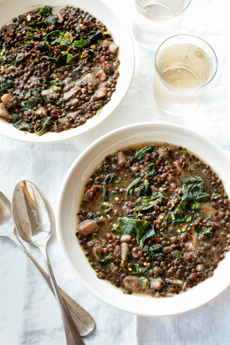
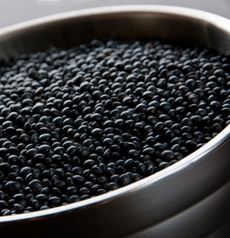
Top: Vegetarian lentil soup with mustard
greens from Good Eggs. Bottom: Black beluga
lentils from InHarvest.com.
|
|
Lentil soup is a winter favorite: hearty, nutritious comfort food. Why make your own? Better lentils, more nuanced flavors and the ability to control the salt.
Today’s tip is an easy recipe for homemade vegetarian lentil soup, with a variation if you’d like to add smoky ham hocks.
LENTILS: AN ANCIENT CROP
Lentils are an ancient food, found in Mediterranean archaeological sites up to 13,000 years old. As with all foods, it first grew wild and was then cultivated, sometime around 8,500 years ago. It grows well in rainfall-challenged climates like the Middle East.
In the Bible (Genesis 25:30-34), Esau, famished after working the fields, gave up his birthright (the rights of the first-born son to inheritance and position) to his younger brother Jacob in exchange for a pot of Jacob’s red lentil soup. The Greek playwright Aristophanes called lentil soup, the “sweetest of delicacies.” [Source]
Plentiful and inexpensive, through much of history lentils have been considered food for the poor. Marie Antoinette made them fashionable in 18th-century France, although elsewhere, even into the 19th century, they were called “poor man’s meat,” and acceptable during Lent for people who could not afford fish. They became a staple in the Middle East and India.
TYPES OF LENTIL SOUP
In modern times, in Europe and the U.S., lentils and lentil soup have moved up, acquiring a position as a hearty and tasty fall and winter comfort food.
Lentil soup can be vegetarian or contain meat. Adding ham hocks or other smoked pork is a popular meat version in Europe and the U.S.
Whether meat or vegetarian, the soup can include vegetables such as carrots, celery, onions, potatoes, pumpkin, tomatoes, turnips and yellow squash/zucchini.
Aromatics and herbs can include bay leaf, cumin, garlic and parsley, plus olive oil and vinegar or lemon juice. Spices popular in Indian recipes include cardamom, cinnamon and fennel seeds.
|
|
It can be garnished with butter or olive oil, chopped herbs, cream or yogurt and/or croutons.
Any lentils can be used: black beluga, brown, green, red or yellow.
The lentils can be cooked with or without the husk. Dehulled red and yellow lentils disintegrate in cooking, losing their shape but making a thick soup. Alternatively, the soup made with husked lentils can be puréed.
WHAT ARE BELUGA LENTILS?
Beluga lentils, also called black beluga lentils and petite beluga lentils, are tiny black lentils that glisten when they’re cooked. Their tiny size and shiny black surface reminded chefs of beluga caviar; hence the name.
They are preferred by fine chefs for pilafs, salads and sides because they hold their shape when cooked and don’t become mushy. They have the same good nutrition profile as other lentil varieties: protein, dietary fiber, iron, potassium and important minerals.
If you can’t find beluga lentils, substitute La Puy French green lentils.
When you cook the lentils, consider making extra lentils to add to a salad or to serve as a side. Start with this recipe for Lentil, Olive & Arugula Salad.
WHAT ARE MUSTARD GREENS?
Mustard greens comprise the leaves and stems of the mustard plant, Brassica juncea. The seeds are used whole as a spice, pressed into mustard oil or ground into mustard powder, which in turn can be mixed with vinegar or wine to create prepared mustard.
The greens are much more prevalent in Asian cooking than in Western recipes. While they have not received the media attention of kale, mustard greens are being discovered for their flavor and nutrition. Mizuna, a “designer green,” is a Japanese mustard plant, Brassica juncea var. japonica. Tatsoi, another Japanese specialty green, is mustard-like but from a different species: Brassica narinosa.
Low in calories, mustard greens are high in vitamins A, C, K and folic acid (also known as vitamin B9 and vitamin M).
|
|
RECIPE: LENTIL SOUP WITH MUSTARD GREENS
This recipe takes 10 minutes of prep time and 45 minutes of cook time. For another vegetarian lentil soup recipe, check out this Red Lentil & Yogurt Soup.
If you’d like to add a smoky meat flavor, use chicken stock plus 3 to 4 smoked ham hocks.
Ingredients For 4 Servings
1 celery root or 2 parsnips, peeled and cubed
½ bunch of carrots, diced (about 2 cups)
1 white onion, diced
4 cloves garlic, sliced
1 bunch mustard greens, destemmed and cut into 1” ribbons
2 cups of beluga lentils
8 cups of chicken or vegetable stock*
2 tablespoons fresh lemon juice†
For meat version: 3-4 ham hocks‡
Optional garnishes: chile flakes; croutons; crumbled feta,
grated Parmesan or similar cheese**; fresh parsley
Optional side: toasted baguette or multigrain, whole grain bread
________________________________
*You can use any combination of broths, or combine broth with water. You can use all water, but the more broth, the more flavor. For a vegetarian version, of course, use vegetable stock.
|
|
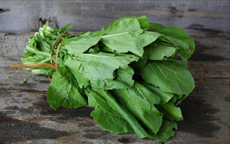
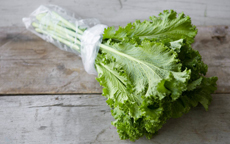

Conventional and red mustard greens. As with kale and other vegetables, different varieties will have different leaf styles. Photos courtesy GoodEggs.
|
†A medium lemon will yield 2-3 tablespoons of juice; a larger lemon can provide 4 tablespoons (1/4 cup).
‡A ham hock, also called the pork knuckle, is the joint where the foot was attached to the hog’s leg.
**Substitutes for crumbled feta or Parmesan in this recipe include include cotija, goat cheese (lightly aged, so it crumbles), queso fresco or ricotta salata.
Preparation
1. PLACE the lentils in a large strainer and rinse them under cold running water. Pick over the lentils and remove any discolored ones, or occasional debris like small pebbles.
2. HEAT 3 tablespoons of olive oil in a stock pot over high heat. When the oil is hot, add the celery root or parsnips, onions, garlic and carrots and cook over high heat for a few minutes. When the garlic starts to turn golden brown, turn the heat down to medium and continue cooking the mixture for about 7 minutes, until the root vegetables begin to soften.
3. ADD the lentils and 8 cups of liquid—this can be any combination of water, stock or just one or the other. Bring to a boil over high heat, then reduce heat to a simmer, cover the pot and cook for 25 minutes, until the lentils are tender. When the lentils are fully cooked…
4. GENTLY STIR stir in the mustard greens and cover the pot. Cook the lentils and greens together for about 5 minutes—just enough for the greens to soften, but still maintain some of their bite. To finish, stir in the lemon juice and salt and pepper to taste. Ladle into bowls and garnish as desired.
Variation With Ham Hocks
1. FOLLOW steps 1 and 2, above.
3. Add the ham hocks (instead of the lentils) and chicken stock. Bring the liquid to a boil, reduce the heat to medium-low and cook for 1 hour, or until the hocks are tender. Then add the lentils and continue cook for 25 minutes, or until the lentils are tender.
4. REMOVE the ham hocks and stir in the mustard greens; allow to cook for 5 minutes, or until the greens soften. While the greens cook, cut the meat from the ham hocks and cube or julienne as desired. Stir the lemon juice into the soup and add the ham. Taste and adjust salt and pepper to taste. Garnish and serve.
|
|





